Women in Forestry: Spotlight on Terri Hall (Florida, USA)
Follow a typical day in the field with one of Rayonier's veteran foresters
Published 03-09-23
Submitted by Rayonier

Few people can say they’ve been with the same company since graduating college 30+ years ago. Forester and Resource Land Manager Terri Hall is one of those people.
“Rayonier was my first permanent job after graduating from college. I started working for Rayonier in 1989 in the old Chandlery Building in downtown Fernandina. At that time, it was known as ITT Rayonier, Corporate was in Connecticut and the timberlands were primarily in Florida and Georgia.”
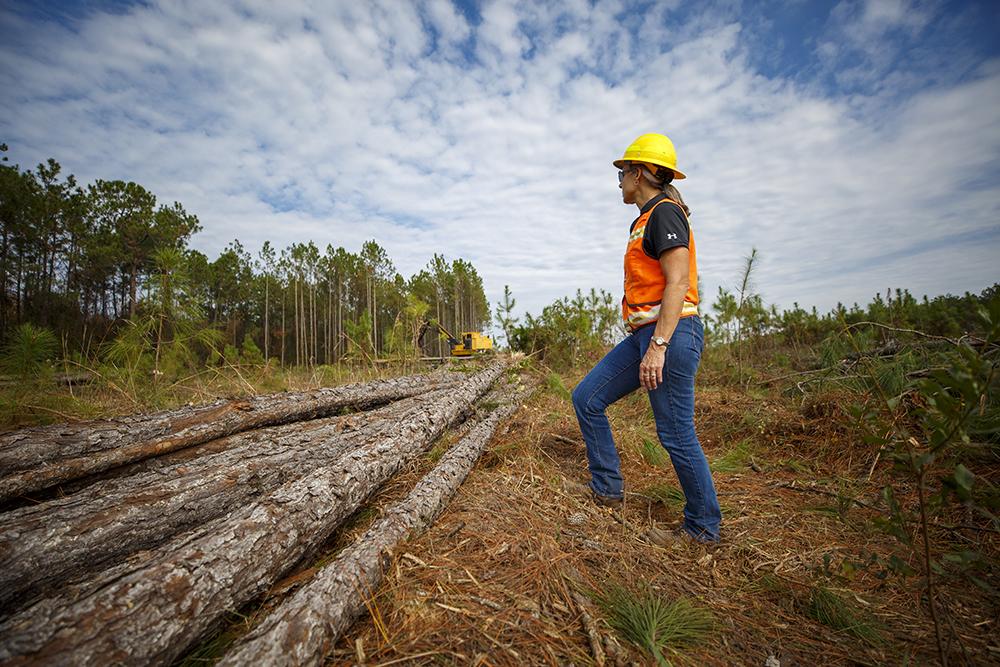
Today, Rayonier’s timberlands span across the Southeast from South Carolina to Texas, and in Washington and Oregon in the Pacific Northwest as well as forests in New Zealand.
Terri soon found her home in Rayonier’s Florida Resource Unit, our team based in Rayonier’s southernmost forests in Florida.
“I started in Technical Services, then worked for the Florida region as a timber sales forester. Since 1992, I have had 5 different job titles but my office for all of them has been right here at the Bradford Forest Office.”
If that isn’t extraordinary enough, her boss has been with her for the span of her career. Rick Piagno, a colleague who eventually became her boss in 1996, is still her boss and Resource Unit Leader today.
“So I’ve had the same boss for 26 years and have worked for the same company for 32 years!” she chuckled.
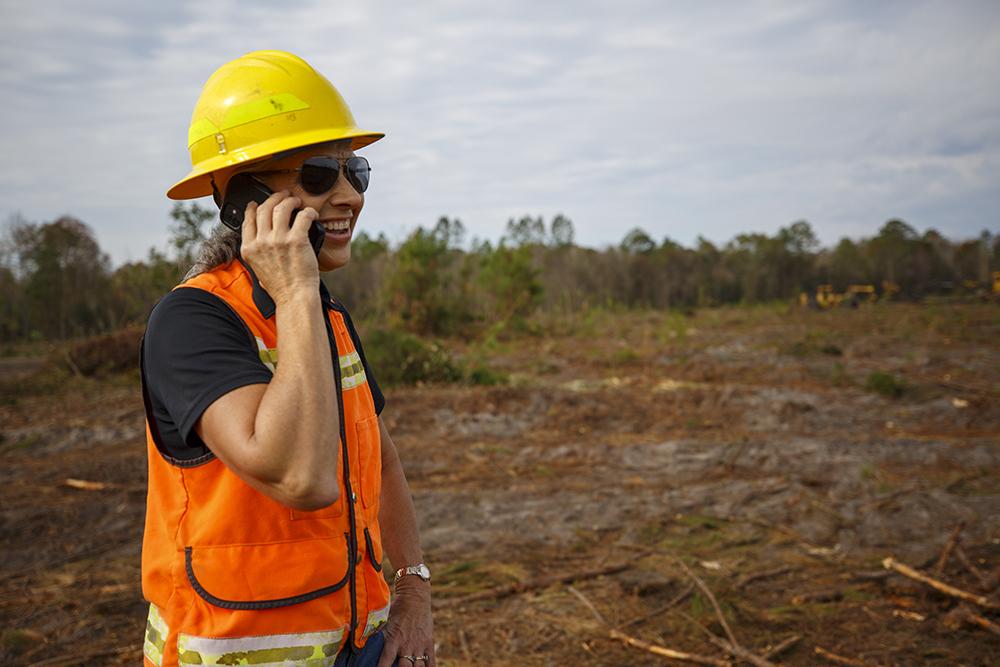
Forging a career path all her own
Many foresters have a family background in the profession or some previous experience, but not Terri. She chose this career based on her own goals and objectives.
“I had no experience and no family background, I just wanted a job that was not going to be boring. I didn’t want to be stuck behind a desk all day long, and I wanted variety in my line of work. I definitely have variety. We always say: don’t make too hard of plans because every morning things are likely to change.”
Terri studied hard to earn her forestry education. She holds a Bachelors and Masters degree from Auburn University. Yet, she still encounters many misconceptions about her field of expertise.
“When I say I’m a forester, people think I sit in a fire tower. So I get to explain all that’s involved, from site management to seed selection, planting, disease control, working with loggers, fire fighting, sampling and statistics. People don’t realize all that goes into the education and daily work of it all.”
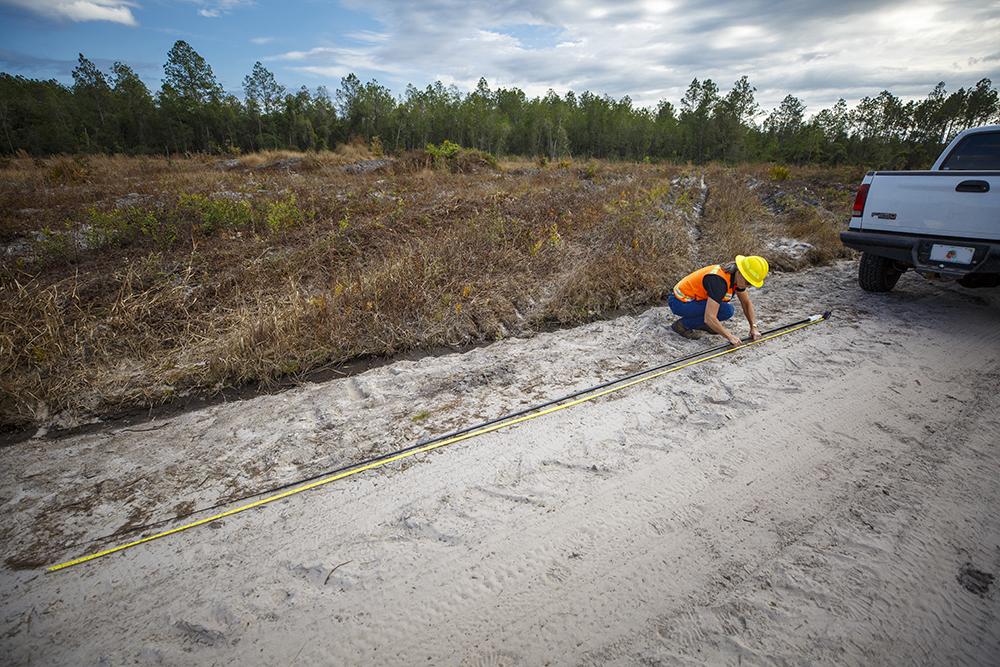
Terri began when few women worked directly in the field
Terri says it never concerned her that she was one of only a few women foresters. Nor did it motivate her to approach her job or make career decisions any differently.
“When I went to school there were 3 other women in my forestry classes. When I began working I think there was — I don’t really pay attention to this — no, there were not any other field women when I came. Then a couple more did come on but most of them did not stay in the field, they went into specialized things like technical services, GIS or research. I don’t know of many who were actually in forest management.
“I’ve never had a problem though. The nice thing about forestry is everyone is so great. Whether it’s Rayonier employees, contractors, loggers or employees with the Florida Forest Service, everyone’s just good, down-to-earth people. I’ve loved every minute of it. Honestly, unless somebody pointed out that I was one of the only women around, I never paid attention to it.”
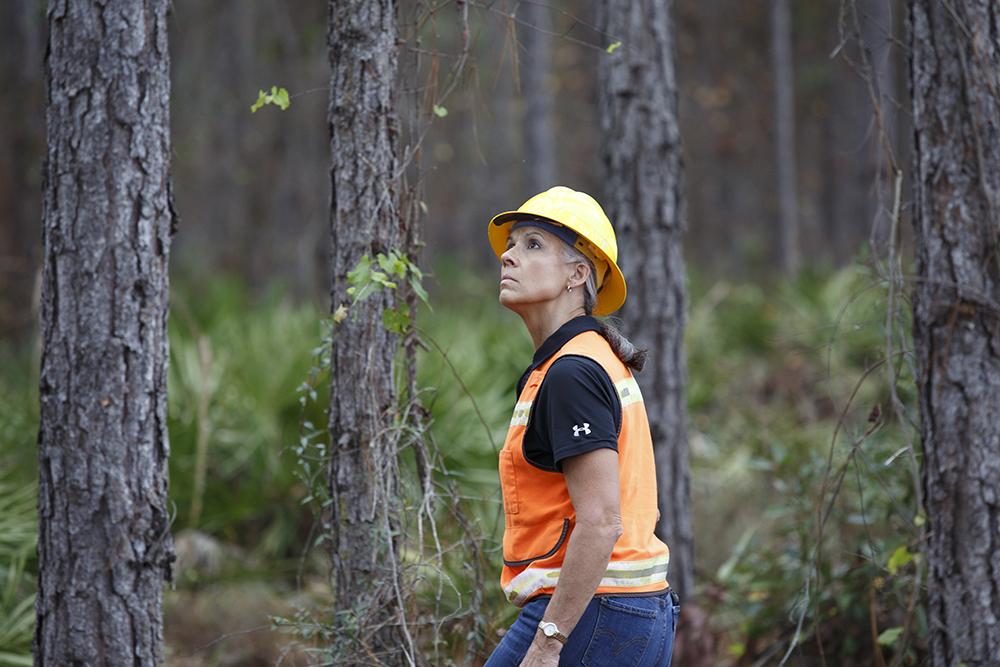
A day in life of this Rayonier forester
In December 2021, when Rayonier employee Robert Hall shadowed Terri for a day and took the photos included in this story, she and her team were dealing with seasonal planting. She began her day in the field supervising planting and taking plots.
“In this picture, I’m laying out my pole to measure it for the correct length for a 35th-acre plot. I then swing the pole and count the seedlings on the plot.”
Terri has to count the number of trees to ensure the contractor is planting the correct density. “Planting compliance is complicated. Planting density can be affected by so many factors including bedding width, quality of the site prep and weather conditions. Really, the only thing a planter can control is how far apart the trees are in the bed.”
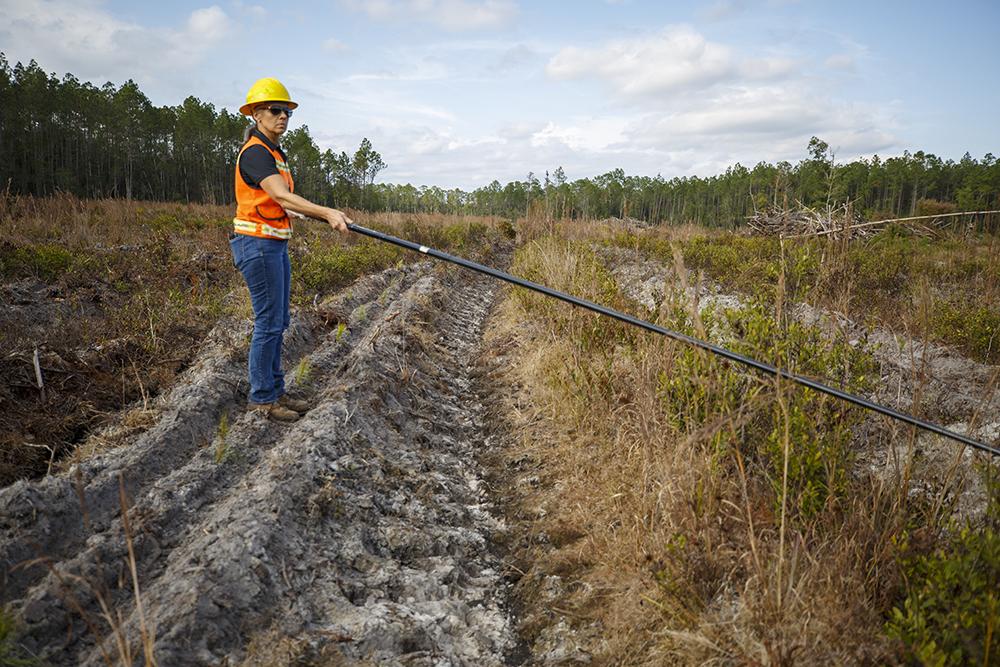
Back at the office, there are forest fire maps to review and analyze
“We do a lot of work looking at fire protection and things we can do to reduce fire danger, especially in Florida. Sometimes that’s through release work, in which we chemically spray under the trees to reduce competition. You create a map of all the stands to show what areas need a reduction in fire danger. After evaluating the map, we make plans for the coming year to do activities in these high risk areas such as mowing or spraying to mitigate the danger.”

Next, it’s on to timber sales — of which Terri has 21 pending for Bradford County
This involves checking in on and meeting with the loggers every 10 days to make sure harvesting is going according to plan.
“When I go out there, my biggest concerns are: stumps being low and trees being cut to the right top diameter so they’re getting proper utilization of the trees. Also, I check that the roads are not being torn up, no oil spills, that the right area’s being cut — you’d be surprised what can happen! — and that they only use our designated crossings. Since it rains a lot in Florida and we’re so close to the water table, we’re also very concerned about soil disturbance and wood not being left on the ground.”
“So I go to the field every week to check on the loggers and walk the timber sale area, making sure they haven’t messed up any sites, channels or roads and ensure they have what they need. I try to maintain a good working relationship with the loggers where they feel free to call and tell me what they need whether it is road work, additional tickets or clarification of the sale area.”

Now, she moves on to overseeing planting and nursery inventory
“Whenever the planting crew works on my forests, I give them maps showing the planting area, number of acres, species to be planted, the seed lot number and the trees per acre to be planted. One of the most challenging things about planting season is getting the seedlings from the nursery to the field when the planters need them. It is a huge coordinated effort when the forests in different states are all planting at once and getting their trees from our one nursery in Elberta, Alabama.”
The seedlings are delivered in refrigerated vans which are left on-site. When that inventory runs low, it’s up to Terri to ensure they have a new van of seedlings on the way so planting isn’t interrupted or delayed.

With the seedlings taken care of, Terri checks on the health of the larger tree stands
No matter how well you plan, cultivate and care for them, some trees are bound to experience pest pressure and/or disease. A regular part of Terri’s work includes evaluating trees for early signs of trouble.
“When you find a spot in a stand where the pine needles are turning red, you look for evidence like pitch tubes, popcorn or sawdust to try and identify the forest pest. Once you figure out the pest, you have to decide on a course of action. For example, if it’s southern pine beetle, we know that pest travels fast! So you might have to cut them down plus create a buffer around them to capture the red, dead and dying. This creates a buffer to protect the healthy trees. So when we see dead spots we have to look at them and see what’s going on.”
This level of consistent observation is critical to preserving and maintaining healthy forests and wildlife habitats.
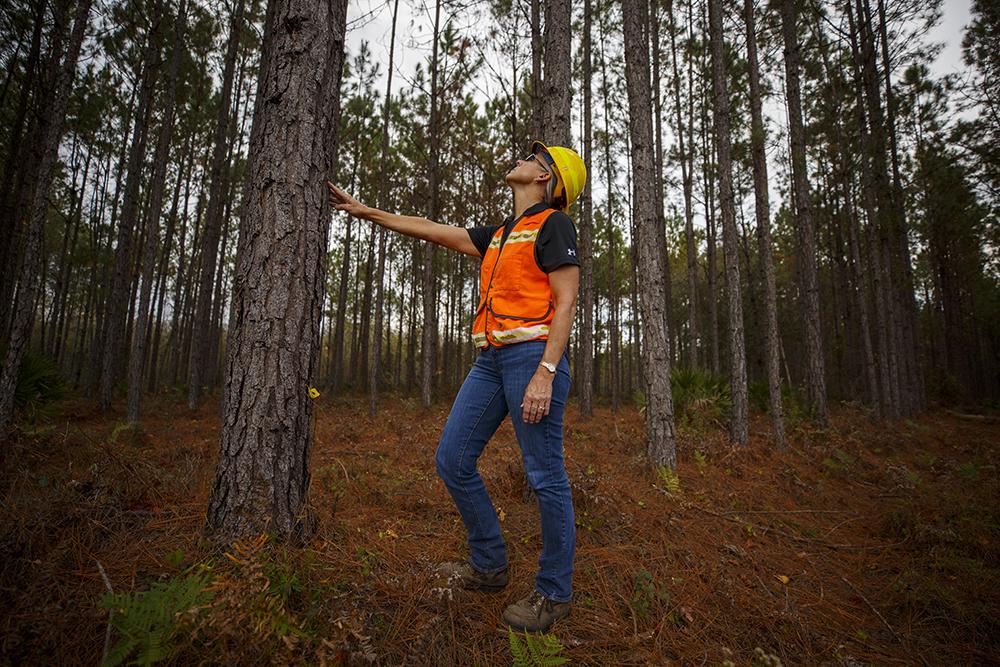
What Terri loves most about being a forester
Terri’s love and passion for her work comes through in everything she does. Here’s what she loves most about her job.
“Some of it has to do with the actual work and some of it has to do with the management. I enjoy the freedom and the responsibility, I’m free to make decisions and I’ve been given a lot of responsibility. I appreciate the trust that’s involved. I like the challenge because we’re always looking for better ways to do this and solutions for the problems that come up. I especially like having an area that’s mine to manage.
“I love that I have the whole spectrum. From the time I put the seedling in the ground to the time the loggers cut it. I choose the seedlings for each stand, I determine whether the stand gets some intermediate treatment, and I’m the one who’s out there helping to protect it either through fire fighting or pest management.
“Another thing I like about my job is how we’re structured. There’s a lot of accountability. If I don’t make sure the logger got it right then I’m going to hear it from the site prep guy. If I don’t ensure that the site prep is right, I am going to hear it from the planting contractor. I’m in charge of the whole rotation. Also, I oversee planning of road work in preparation for new timber sales so just about anything that happens, it’s my responsibility…and I like that.”
Terri adds: “I’ll tell you a secret, the Florida Resource Unit is the best. We have a great time together, we really do!”

Rayonier
Rayonier
Rayonier (NYSE:RYN) is a leading timberland real estate investment trust with assets located in some of the most productive softwood timber growing regions in the United States and New Zealand. We own or lease under long-term agreements approximately 2.8 million acres of timberlands located in the U.S. South, U.S. Pacific Northwest and New Zealand. We are More than trees because we recognize that our 90+ years of success in the timberland industry comes from our people, an empowering culture and the courage to constantly challenge “the way it’s always been done.” Get to know us at www.rayonier.com.
More from Rayonier

